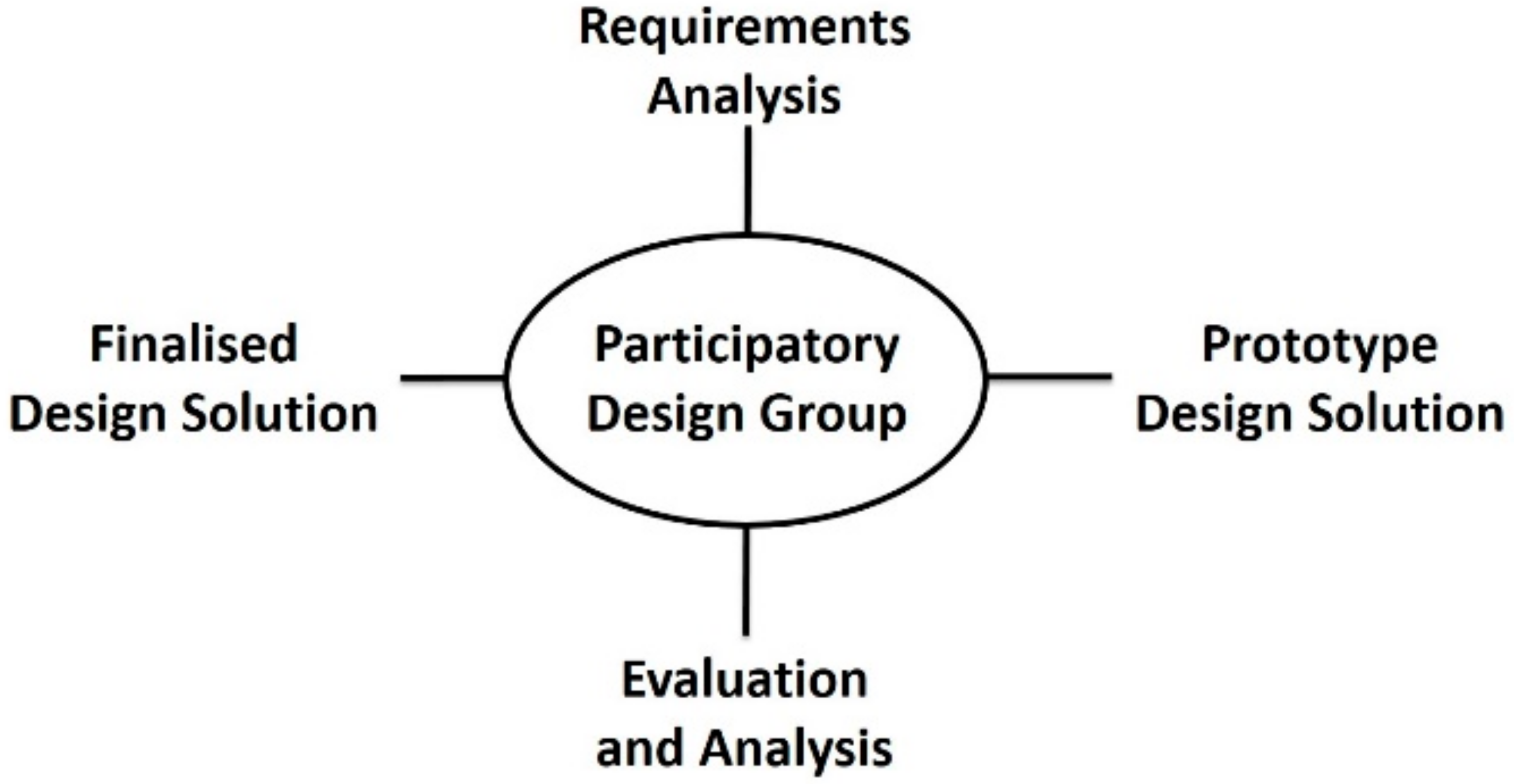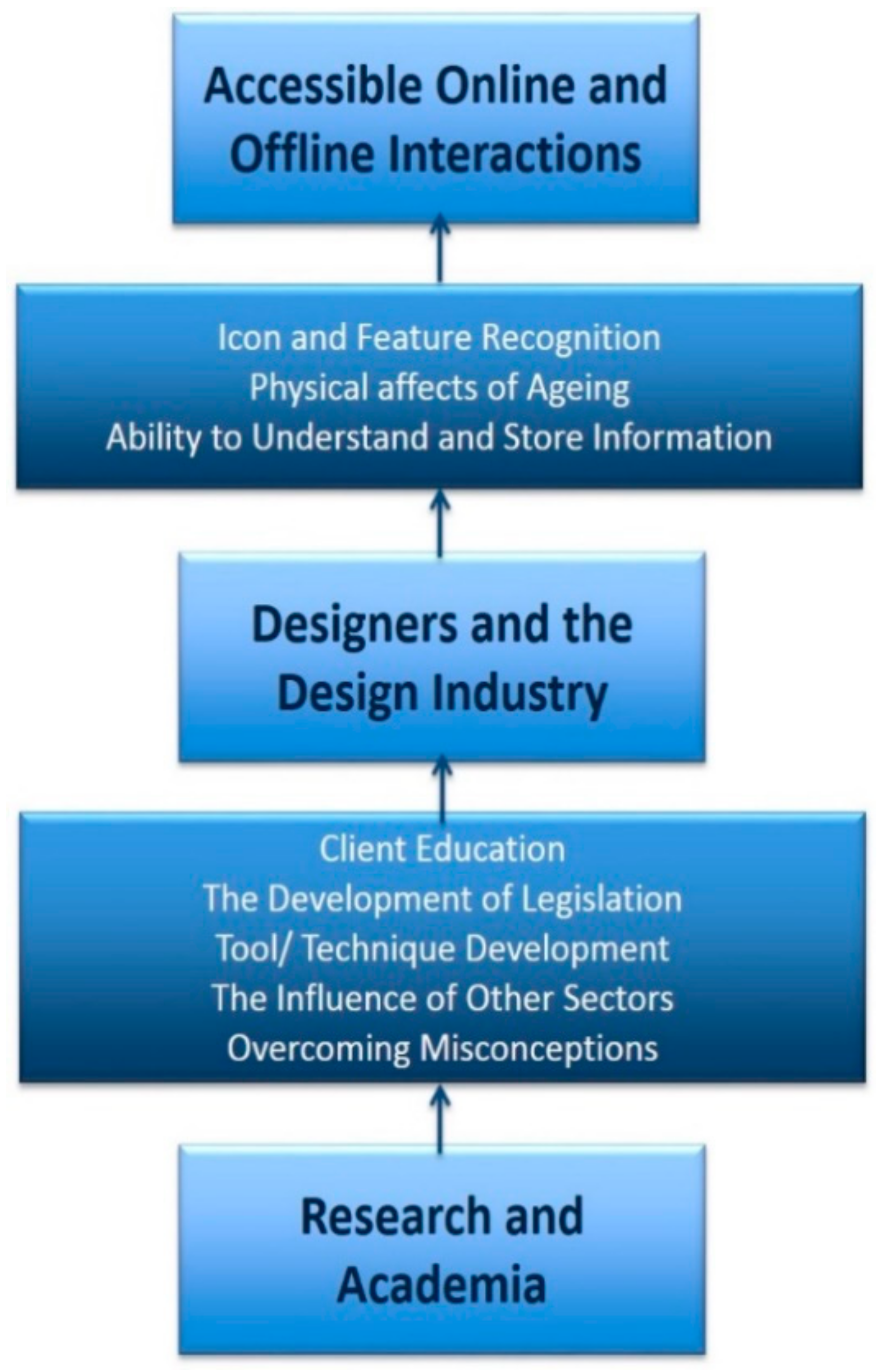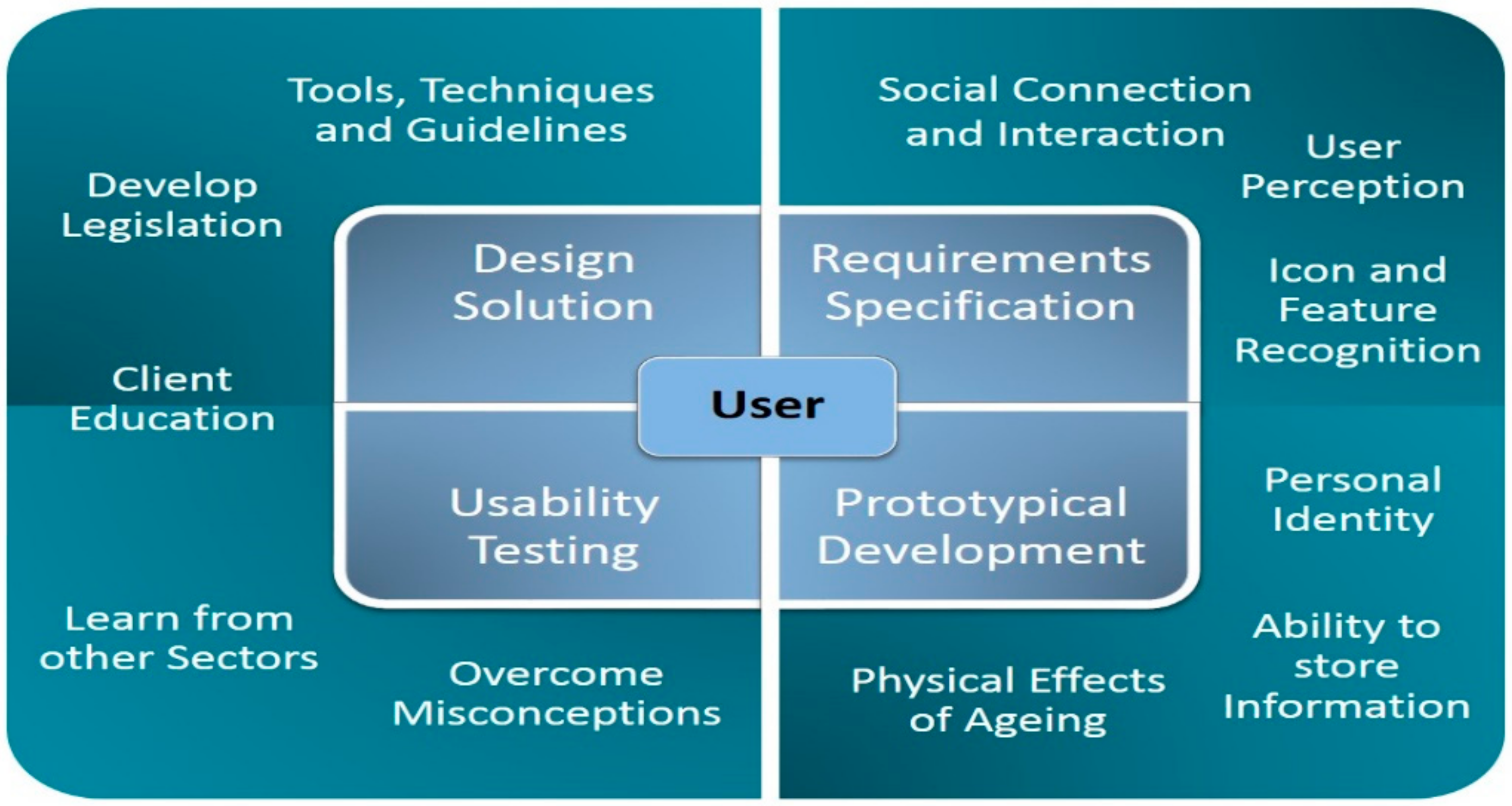An Overview of Participatory Design Applied to Physical and Digital Product Interaction for Older People
Abstract
1. Introduction
2. Older People and Design
2.1. Older Users and the Design of Physical Products
- Younger people performed more efficiently and effectively.
- Younger people possessed a greater ability to store and recall information, and were optimally positioned to recognise, understand, and acquire iconic information.
- Increases in age correlated to decreases in the ability to acquire product feature knowledge.
- The younger generation were able to acquire knowledge and accurately determine more product features and appeared advantageously placed to interact more effectively with contemporary technology.
2.2. Older Users and the Design of Digital Interactions
3. Involving Older People in the Design Process
3.1. Involving Users in Physical Product Development
3.2. Involving Users in Digital and Online Design
- ISO/IEC 40500:2012-IT-W3C Web Content Accessibility Guidelines 2.0 [43];
- ISO 9241-171:2008-IT-Accessibility and Ergonomics [44];
- ISO/IEC 24786:2009-User Interfaces [45];
- Section 508 of the Telecommunication Act 1998 [46];
- Jakob Nielsen’s Usability Heuristics Jakob Nielsen [47];
- The RNIB See it Right guidelines (compliant with the Disability Discrimination Act) [48];
- National Institute on Ageing’s guide to Making Your Website Senior Friendly [49].
4. Discussion
- Visually accessible design is just for the severely visually impaired;
- Considering the user’s visual capabilities is more time consuming and difficult than it is worth;
- You cannot create both stylish and accessible designs.
5. Conclusions
5.1. How Might Older People Benefit?
5.2. Closing Remarks
Author Contributions
Funding
Conflicts of Interest
References
- Nesta: Innovation Must Match Challenge of Ageing Population. Available online: http://www.nesta.org.uk/news/innovation-must-match-challenge-ageing-population-says-nesta (accessed on 2 September 2018).
- Population Trends: UK Population Changes. Available online: http://www.telegraph.co.uk/news/uknews/8191962/UK-population-ageing-slower-than-most-of-Europe.html (accessed on 2 September 2018).
- Wilkinson, C. Involving teenagers today in the design of tomorrow’s technology. In Perspectives on HCI Research with Teenagers; Little, L., Toth, N., Bell, B., Fitton, D., Eds.; Springer: Cham, Switzerland, 2016; pp. 179–206. ISBN 9783319334486. [Google Scholar]
- Czaja, S.; Charness, N.; Fisk, A.; Hertzog, C.; Nair, S.; Rogers, W.; Sharit, J. Factors predicting the use of technology: Findings from the Center for Research and Education on Aging and Technology Enhancement (CREATE). Psychol. Aging 2006, 21, 333–352. [Google Scholar] [CrossRef] [PubMed]
- Docampo-Rama, M. Technology Generations Handling Complex User Interfaces. Ph.D. Thesis, Eindhofen University of Technology, Eindhofen, The Netherlands, January 2001. [Google Scholar]
- Weiss, S. Handheld Usability; John Wiley & Sons: Chichester, UK, 2002; ISBN 0470844469. [Google Scholar]
- Freudenthal, D. Age differences in the performance of information retrieval tasks. Behav. Inf. Technol. 2001, 20, 9–22. [Google Scholar] [CrossRef]
- Wilkinson, C.; Langdon, P.; Clarkson, P.J. Exploring prior experience and the effects of age on product interaction and learning. In Design, User Experience, and Usability: Web, Mobile, and Product Design; Springer: Berlin, Germany, 2013; pp. 457–466. ISBN 978-3-642-39252-8. [Google Scholar]
- Kim, Y.; Kang, J.; Kim, M. The relationships among family and social interaction, loneliness, mall shopping motivation spending of older consumers. Psychol. Mark. 2005, 22, 995–1015. [Google Scholar] [CrossRef]
- König, R.; Seifert, A.; Doh, M. Internet use among older Europeans: An analysis based on SHARE data. Univers. Access Inf. Soc. 2018, 17, 17–633. [Google Scholar] [CrossRef]
- Tanner, D.; Harris, J. Working with Older People (The Social Work Skills Series); Routledge: London, UK, 2007; ISBN 9780415354219. [Google Scholar]
- Rabbitt, P.; Scott, M.; Thacker, N.; Lowe, C.; Jackson, A.; Horan, M.; Pendleton, N. Losses in gross brain volume and cerebral blood flow account for age-related differences in speed but not in fluid intelligence. Neuropsychology 2006, 20, 549–557. [Google Scholar] [CrossRef] [PubMed]
- Lowsky, D.; Olshansky, J.; Bhattacharya, J.; Goldman, D. Heterogeneity in healthy aging. J. Gerontol. Ser. A Biol. Sci. Med. Sci. 2014, 69, 640–649. [Google Scholar] [CrossRef] [PubMed]
- Goodman-Deane, J.; Keith, S.; Whitney, G. HCI and the older population. Univers. Access Inf. Soc. 2009, 8, 1–3. [Google Scholar] [CrossRef]
- Wilkinson, C.; De Angeli, A. Applying user centred and participatory design approaches to commercial product development. J. Des. Stud. 2014, 35, 614–631. [Google Scholar] [CrossRef]
- Wilkinson, C.; Gandhi, D. Future Proofing Tomorrows Technology: UX for an Ageing Population. User Experience Magazine, UXPA, 15.1. Available online: http://uxpamagazine.org/future-proofing-tomorrows-technology (accessed on 2 September 2018).
- Wilkinson, C. Evaluating the Role of Prior Experience in Inclusive Design. Ph.D. Thesis, University of Cambridge, Cambridge, UK, November 2011. [Google Scholar]
- Preece, J.; Rogers, Y.; Sharp, H. Interaction Design: Beyond Human-Computer Interaction; John Wiley & Sons: New York, NY, USA, 2002; ISBN 0-471-49278-7. [Google Scholar]
- Langdon, P.; Lewis, T.; Clarkson, J. Prior experience in the use of domestic product interfaces. Univers. Access Inf. Soc. 2010, 9, 209–225. [Google Scholar] [CrossRef]
- Blackler, A. Intuitive Interaction with Complex Artefacts. Ph.D. Thesis, Queensland University of Technology, Brisbane, Australia, June 2006. [Google Scholar]
- Lewis, T.; Langdon, P.; Clarkson, J. Investigating the role of experience in the use of consumer products. In Designing Accessible Technology; Clarkson, J., Langdon, P., Robinson, P., Eds.; Springer: London, UK, 2006; pp. 189–198. ISBN 978-1-84628-365-9. [Google Scholar]
- Lewis, T.; Langdon, P.; Clarkson, J. Prior experience of domestic microwave cooker interfaces: A user study. In Designing Inclusive Futures; Clarkson, J., Langdon, P., Robinson, P., Eds.; Springer: London, UK, 2008; pp. 95–106. ISBN 9781848002104. [Google Scholar]
- Darvishy, A.; Hutter, H.; Seifert, A. Age-Appropriate Mobile Applications; Zürcher Hochschule für angewandte Wissenschaften (ZHAW): Winterthur, Switzerland, 2017; Available online: https://www.researchgate.net/publication/319136774_Age-Appropriate_Mobile_Applications (accessed on 5 November 2018).
- Rogers, W.; Fisk, A. Toward a psychological science of advanced technology design for older adults. J. Gerontol. Ser. B Psychol. Sci. Soc. Sci. 2010, 65, 645–653. [Google Scholar] [CrossRef] [PubMed]
- Schulz, R.; Wahl, H.; Matthews, J.; De Vito Dabbs, A.; Beach, S.; Czaja, S. Advancing the aging and technology agenda in gerontology. Gerontologist 2015, 55, 724–734. [Google Scholar] [CrossRef] [PubMed]
- Wagner, N.; Hassanein, K.; Head, M. Computer use by older adults: A multi-disciplinary review. Comput. Hum. Behav. 2010, 26, 870–882. [Google Scholar] [CrossRef]
- Hart, T.; Chaparro, B.; Halcomb, C. Evaluating websites for older adults: Adherence to senior-friendly guidelines and end-user performance. Behav. Inf. Technol. 2008, 27, 191–199. [Google Scholar] [CrossRef]
- Vuori, S.; Holmlund-Rytkönen, M. 55+ people as internet users. Mark. Intell. Plan. 2005, 23, 58–76. [Google Scholar] [CrossRef]
- Nominet Trust: Ageing and the Use of the Internet. Available online: http://library.bsl.org.au/showitem.php?handle=1/2869 (accessed on 2 September 2018).
- Eurostat. Data in Focus 50/2010: Internet Usage in 2010—Households and Individuals. Available online: http://epp.eurostat.ec.europa.eu/cache/ITY_OFFPUB/KS-QA-10-050/EN/KS-QA-10-050-EN.PDF (accessed on 2 September 2018).
- Pfeil, U.; Arjan, R.; Zaphiris, P. Age differences in online social networking—A study of user profiles and the social capital divide among teenagers and older users in MySpace. Comput. Hum. Behav. 2009, 25, 643–654. [Google Scholar] [CrossRef]
- Bucur, A.; Renold, C.; Henke, M. How do older netcitizens compare with their younger counterparts? Cyberpsychol. Behav. 1999, 2, 505–513. [Google Scholar] [CrossRef] [PubMed]
- Seifert, A.; Doh, M.; Wahl, H. They also do it: Internet use by older adults living in residential care facilities. Educ. Gerontol. 2017, 43, 451–461. [Google Scholar] [CrossRef]
- Cleaver, J. Surfing for seniors. Mark. New. 1999, 33, 1–7. [Google Scholar]
- Hawthorn, D. Possible implications of aging for interface designers. Interact. Comput. 2000, 12, 507–528. [Google Scholar] [CrossRef]
- Kurniawan, S.; Zaphiris, P. Research-derived web design guidelines for older people. In Proceedings of the 7th International ACM SIGACCESS Conference on Computers and Accessibility, Baltimore, MA, USA, 9–12 October 2005; ACM: New York, NY, USA, 2005; pp. 129–135, ISBN 1-59593-159-7. [Google Scholar]
- Dsign Council: Design Industry Research Report. Available online: https://www.designcouncil.org.uk/sites/default/files/asset/document/DesignIndustryResearch2010_FactSheets_Design_Council.pdf (accessed on 2 September 2018).
- Wilkinson, C.; Walters, A.; Evans, J. Creating and testing a model driven framework for accessible user-centric design. Des. J. 2016, 19, 69–91. [Google Scholar] [CrossRef]
- Sanders, E. From user-centred to participatory design approaches. In Design and the Social Sciences: Making Connections (Contemporary Trends Institute; Frascara, J., Ed.; Taylor & Francis: London, UK, 2002; pp. 1–9. ISBN 9780415273763. [Google Scholar]
- Mao, J.Y.; Vredenburg, K.; Smith, P.; Carey, T. The State of User Centred Design Practice. Commun. ACM 2005, 48, 105–109. [Google Scholar] [CrossRef]
- Von Hippel, E. Lead users: A source of novel product concepts. Manag. Sci. 1986, 32, 791–805. [Google Scholar] [CrossRef]
- Abascal, J.; Nicolle, C. Moving towards inclusive design guidelines for socially and ethically aware HCI. Interact. Comput. 2005, 17, 484–505. [Google Scholar] [CrossRef]
- ISO. ISO/IEC 40500:2012—IT—W3C Web Content Accessibility Guidelines (WCAG) 2.0. Available online: http://www.iso.org/iso/iso_catalogue/catalogue_tc/catalogue_detail.htm?csnumber=58625 (accessed on 2 September 2018).
- ISO 9241-171:2008—Ergonomics of Human-System Interaction—Part 171: Guidance on Software Accessibility. Available online: http://www.iso.org/iso/iso_catalogue/catalogue_ics/catalogue_detail_ics.htm?csnumber=39080 (accessed on 2 September 2018).
- ISO/IEC 24786:2009—IT—User Interfaces—Accessible User Interface for Accessibility Settings. Available online: http://www.iso.org/iso/catalogue_detail.htm?csnumber=41556 (accessed on 2 September 2018).
- Telecommunications Act. General Services Administration: Section 508. 1998. Available online: http://www.section508.gov (accessed on 2 September 2018).
- Nielsen, J. Usability Engineering; Morgan Kaufmann Publishers Inc.: San Francisco, CA, USA, 1995; ISBN 0125184069. [Google Scholar]
- RNIB Audits. Available online: http://www.rnib-business.org.uk/Audits (accessed on 2 September 2018).
- National Institute on Ageing. Making your Website Senior Friendly. Available online: https://www.nlm.nih.gov/pubs/checklist.pdf (accessed on 2 September 2018).
- WebAim. Web Accessibility in Mind. Available online: http://webaim.org (accessed on 2 September 2018).
- W3C2014: W3C’s Web Accessibility Evaluation Tools List. Available online: https://www.w3.org/WAI/ER/tools (accessed on 2 September 2018).
- Dong, H.; McGinley, C.; Nickpour, F.; Cifter, A. Designing for designers: Insights into the knowledge users of inclusive design. Appl. Ergon. 2015, 46, 284–291. [Google Scholar] [CrossRef] [PubMed]
- Judd, E. Serving seniors online. Bank. Strateg. 2000, 76, 24–30. [Google Scholar]
- Clarkson, J. Designing a more inclusive world. In Inclusive Buildings, Products & Services: Challenges in Universal Design; Vavic, T., Ed.; Tapir Academic Press: Trondheim, Norway, 2009; ISBN 10-8251923441. [Google Scholar]
- Aula, A. User study on older adults’ use of the web and search engines. Univers. Access Inf. Soc. 2005, 4, 67–81. [Google Scholar] [CrossRef]
- GOV.UK. Testing Gov.uk with Real Users. Available online: https://gds.blog.gov.uk/2012/10/05/testing-gov-uk-with-real-users (accessed on 2 September 2018).
- Hart, T.; Chaparro, B. Evaluation of websites for older adults: How senior friendly are they? Usability New. 2004, 6, 12. [Google Scholar]
- Eisma, R.; Dickinson, A.; Goodman-Deane, J.; Syme, A.; Newell, A. Early user involvement in the development of information technology-related products for older people. Univers. Access Inf. Soc. 2004, 3, 131–140. [Google Scholar] [CrossRef]
- Cornish, K.; Goodman-Deane, J.; Ruggeri, K.; Clarkson, P.J. Visual accessibility in graphic design: A client–designer communication failure. Des. Stud. 2015, 40, 176–195. [Google Scholar] [CrossRef]
- Cornish, K.; Goodman-Deane, J.; Clarkson, P.J. Visual accessibility misconceptions held by graphic designers and their clients. In Contemporary Ergonomics and Human Factors, Proceedings of the International Conference on Ergonomics and Human Factors 2015, Daventry, UK, 13–16 April 2015; Taylor and Francis: London, UK, 2015; pp. 72–79. ISBN 9781138028036. [Google Scholar]
- British Standards Institute: BS 8300:9.2.1.1—Design Standards for Accessible Railway Stations. Available online: https://www.gov.uk/government/uploads/system/uploads/attachment_data/file/415638/design-standards-accessiblestations.pdf (accessed on 2 September 2018).
- European Commission. Guidelines on the Readability of the Label and Package Leaflet of Medicinal Products for Human Use. Available online: http://ec.europa.eu/health/files/eudralex/vol-2/c/2009_01_12_readability_guideline_fi nal_en.pdf (accessed on 2 September 2018).
- Cardoso, C.; Clarkson, J. Simulation in user-centred design: Helping designers to empathise with atypical users. J. Eng. Des. 2012, 23, 1–22. [Google Scholar] [CrossRef]
- Keates, S.; Clarkson, J. Countering Design Exclusion: An Introduction to Inclusive Design; Springer: London, UK, 2003; ISBN 9781852337698. [Google Scholar]
- Deisinger, J.; Breining, R.; Robler, A.; Holfe, J.; Ruckert, D. Immersive ergonomics analyses of console elements in a tractor cabin. In Proceedings of the Fourth Immersive Projection Technologies Workshop, Ames, IA, USA, 19–20 June 2000. [Google Scholar]
- Rasmussen, J. Deciding and doing: Decision making in natural context. In Decision Making in Action: Models and Methods; Klein, G., Orasanu, J., Calderwood, R., Zsambok, C., Eds.; Ablex: Norwood, OH, USA, 1993; ISBN 13 9780893919436. [Google Scholar]



| Internet Usage | 16–24 Year Olds | 55–74 Year Olds |
|---|---|---|
| Use the Internet on average at least once a week | 90 | 37 |
| Send or receive email | 90 | 85 |
| Post to chat sites, blogs, or social networking sites | 80 | 20 |
| Use the Internet for phone or video calls | 35 | 20 |
| Use the Internet to read news and newspapers | 45 | 50 |
| Use the Internet for learning | 80 | 35 |
| Search for information on courses | 50 | 20 |
| Follow e-learning courses | 10 | 5 |
© 2018 by the authors. Licensee MDPI, Basel, Switzerland. This article is an open access article distributed under the terms and conditions of the Creative Commons Attribution (CC BY) license (http://creativecommons.org/licenses/by/4.0/).
Share and Cite
Wilkinson, C.; Cornish, K. An Overview of Participatory Design Applied to Physical and Digital Product Interaction for Older People. Multimodal Technol. Interact. 2018, 2, 79. https://doi.org/10.3390/mti2040079
Wilkinson C, Cornish K. An Overview of Participatory Design Applied to Physical and Digital Product Interaction for Older People. Multimodal Technologies and Interaction. 2018; 2(4):79. https://doi.org/10.3390/mti2040079
Chicago/Turabian StyleWilkinson, Christopher, and Katie Cornish. 2018. "An Overview of Participatory Design Applied to Physical and Digital Product Interaction for Older People" Multimodal Technologies and Interaction 2, no. 4: 79. https://doi.org/10.3390/mti2040079
APA StyleWilkinson, C., & Cornish, K. (2018). An Overview of Participatory Design Applied to Physical and Digital Product Interaction for Older People. Multimodal Technologies and Interaction, 2(4), 79. https://doi.org/10.3390/mti2040079





